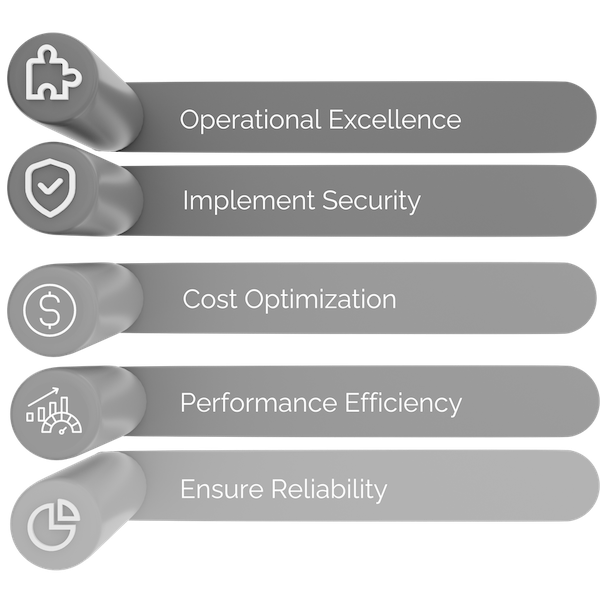Integrating HiveMQ Platform with a Well-Architected Framework
Integrating HiveMQ broker with a well-architected framework on the lines of AWS Well-Architected Framework, Azure Well-Architected Framework, and Google Cloud Architecture Framework involves designing a solution that adheres to each of these framework's best practices and principles.
A well-architected framework comprises five pillars: Operational Excellence, Cost Optimization, Performance Efficiency, Reliability, and Security.

HiveMQ is the perfect building block for a well-architected landscape.
Let's dive into some of the unique features of the HiveMQ platform that make it a great fit:
1. Operational Excellence
Operational Excellence refers to the ability to deploy an application reliably and to verify that deployment.
Implement Infrastructure as Code (IaC):
Use tools like Terraform, Bicep, ARM, CloudFormation, and Deployment Manager to define and deploy your HiveMQ cluster infrastructure.
Enable version control for your infrastructure code to track changes and roll back if necessary.
Implement CI/CD pipelines:
Set up continuous integration and continuous deployment (CI/CD) pipelines to automate HiveMQ deployment and updates.
Integrate monitoring and testing into your CI/CD pipelines for proactive issue detection.
Enable logging and monitoring:
Implement logging and monitoring using, for example, Azure Monitor or Amazon CloudWatch.
Set up alerts based on key performance and reliability metrics provided by the cloud and by HiveMQ Prometheus endpoint.
Document and train:
Document your architecture, deployment processes, and troubleshooting procedures.
Provide training for your team on services used in your HiveMQ solution.
2. Cost Optimization
Cloud providers can provide resources to host nearly all your services, but they can quickly cost a lot of money. Safeguards need to be put in place using at least the tools offered by cloud providers.
Cost tracking and optimizations:
Monitor and analyze the usage of your HiveMQ platform to identify any underutilized resources and optimize the costs.
Rightsizing your resources is an effective way to optimize your cloud costs. HiveMQ clusters can scale up and down to meet your needs.
Regroup resources that are dependent on each other in the same region to limit extra networking costs; for example, Kubernetes clusters with databases and/or data lake used by your HiveMQ deployment are all deployed in a single region with multiple availability zones.
3. Performance Efficiency
Performance efficiency in the cloud refers to the ability to use computing resources efficiently to meet system requirements and to maintain that efficiency as demand changes and technologies evolve.
Well-designed infrastructure:
Choose the appropriate cloud services for hosting your HiveMQ broker based on performance requirements. For example, you might consider a Kubernetes cluster to host a HiveMQ cluster instead of multiple Linux virtual machines.
Optimize network performance by selecting the appropriate regions.
Implement automation:
Set up alerts based on key performance and reliability metrics.
Automate scaling based on multiple performance metrics or based on anticipated consumption peaks. HiveMQ is well suited for scaling in and out.
4. Ensure Reliability
Reliability is the ability to keep an application or service running, to anticipate failures, and to have a plan to recover quickly from those failures.
Reliability:
Design for high availability by deploying your HiveMQ broker in multiple Azure regions or availability zones. Keep in mind that latency between nodes is key for a high-performance HiveMQ cluster.
Use monitoring tools to detect and diagnose issues proactively.
Implement proper error handling and retries in your MQTT client applications.
5. Implement Security
Security is an important topic when architecting any infrastructure or application, whether or not it is in the cloud. It is also one of the more complex topics to address in software development. A key principle when you design your infrastructure/application is Zero Trust: never trust users you know! A good approach for that is to identify layers to protect your control planes, resources, and data.
Security on the cloud provider:
Address security at all levels. Implement identity and access management (IAM).
Encrypt data in transit using TLS/SSL.
Implement network security groups to control traffic to your HiveMQ platform.
Regularly review the logs and update security policies.
Ensure compliance with industry regulations and standards relevant to your application.
Security on the HiveMQ platform:
Encrypt data in transit using TLS/SSL.
Protect your client connections with mutual TLS and authenticate the client with certificates.
Implement granular permissions with the Enterprise Security Extension.
Implement a firewall to add a second layer of control on the traffic to your HiveMQ broker.
Regularly review the logs and update security policies.
To Wrap Up
Remember that the specific implementation details will depend on your company policy and on your use case with your HiveMQ platform. Regularly reviewing and updating your architecture based on feedback and changes is crucial to maintaining alignment with the Well-Architected Framework principles.

Anthony Olazabal
Anthony is part of the Solutions Engineering team at HiveMQ. He is a technology enthusiast with many years of experience working in infrastructures and development around Azure cloud architectures. His expertise extends to development, cloud technologies, and a keen interest in IaaS, PaaS, and SaaS services with a keen interest in writing about MQTT and IoT.
